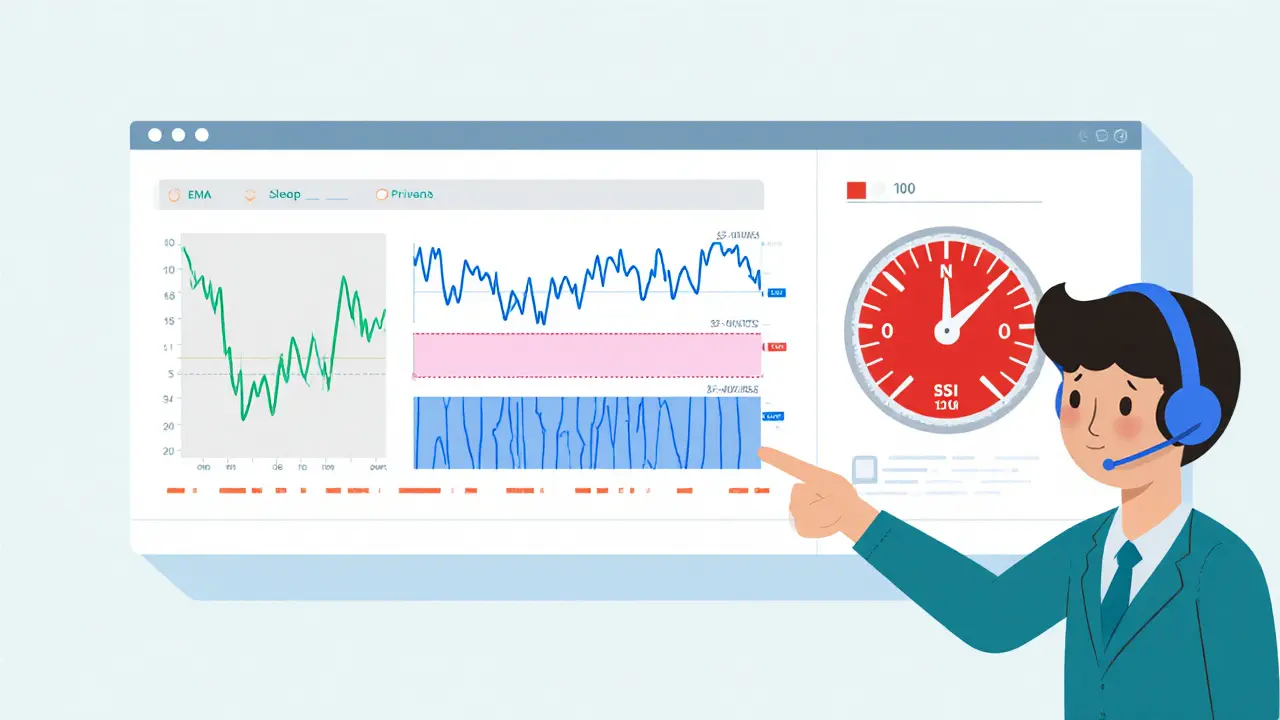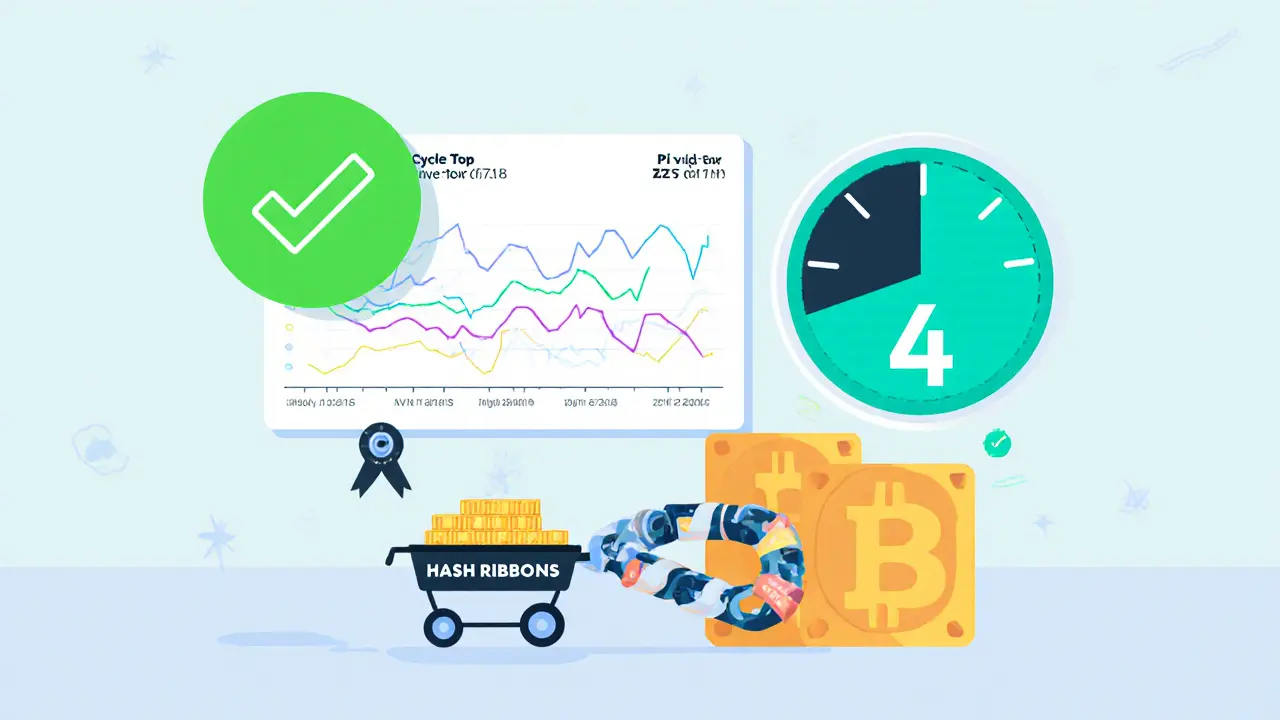Top Bitcoin Technical Indicators Every Trader Should Use
 Aug, 11 2025
Aug, 11 2025
Bitcoin Indicator Signal Analyzer
Input Your Indicator Values
Enter values for your selected indicators to see how they combine for actionable signals
When it comes to navigating Bitcoin’s wild price swings, Bitcoin technical indicators are the compass many traders rely on.
In the world of crypto, indicators transform raw price, volume, and on‑chain data into visual cues you can act on. Below you’ll find the most essential tools, how they work, and practical tips for using them together without getting lost in the noise.
Why Technical Indicators Matter for Bitcoin
Bitcoin trades 24/7, processes roughly $25 billion in daily volume, and can swing more than 10 % in a single day about 15 % of the time (Glassnode, 2023). Traditional charting alone can’t capture that speed. Indicators give you a statistical edge by summarizing trends, momentum, and market sentiment in a way that the naked eye can’t.
Expert voices echo the same point. Pierre Rochard of Kraken notes that discretionary traders achieve the best results when they combine price action with two or three complementary indicators. The goal isn’t to predict the future perfectly-just to raise the odds of catching a meaningful move.
Traditional Price‑Based Indicators
These are the workhorses imported from stocks and forex. They use price and volume alone, so they’re easy to read on any charting platform.
Relative Strength Index (RSI) is a momentum oscillator that measures the speed and change of price movements on a 0‑100 scale. Readings above 70 suggest overbought conditions; below 30 suggest oversold. During the 2020‑2021 bull run, RSI stayed above 70 for 157 consecutive days, showing how Bitcoin can stay overbought for long stretches.
Bollinger Bands are a volatility envelope that plots a 20‑period moving average plus and minus two standard deviations. When bands widen, volatility is expanding; when they squeeze, a breakout may be imminent. CryptoQuant’s analysis of the 2022 bear market shows Bollinger Bands generated 32 % more false breakouts during downtrends, so combine them with a trend filter.
Moving Average Convergence Divergence (MACD) is the difference between a 12‑period and a 26‑period exponential moving average, with a 9‑period signal line. Cross‑overs signal possible trend changes, but in sideways markets like Q1 2024 the indicator produced more whipsaws than winners for many traders.
Simple moving averages (SMA) and exponential moving averages (EMA) also remain popular. David Ellefson of CoinShares recommends a 55‑day EMA over the classic 50‑day to better align with Bitcoin’s weekly volatility pattern.
On‑Chain Metrics That Go Beyond Price
Because Bitcoin’s blockchain is public, analysts can read the behavior of the actual coins. On‑chain metrics add a layer of insight that pure price tools miss.
Pi Cycle Top is a market‑cycle indicator that triggers when the 111‑day moving average crosses above twice the 350‑day moving average. Since its introduction in 2019, it correctly signaled three of the four major tops (2017, 2021, 2024) but missed the March 2020 pandemic crash.
MVRV Z‑Score is the ratio of market value to realized value, expressed as a Z‑score, where values above 3.7 usually indicate overvaluation. Willy Woo reported an 83 % accuracy rate for spotting tops and bottoms when combined with traditional analysis.
Short‑Term Holder Realized Price (STH RP) is the average price at which coins held for 155 days or less were last moved, often acting as a strong support level in downturns. Glassnode’s 2024 user report shows beginners frequently misread this metric in their first market cycle.
Hash Ribbons are a series of moving averages on hash‑rate data that highlight miner capitulation events. The indicator only gave five major signals between 2016‑2023, making it a niche but powerful tool for spotting network stress.

Combining Indicators for Better Signals
No single tool wins every battle. The sweet spot is a blend of a leading indicator (like RSI) with a lagging one (like a 200‑day EMA) and an on‑chain metric for market context.
Reddit user BitcoinTrader87 shared a 67 % win rate by pairing a 200‑day moving average with RSI on a 4‑hour chart. Conversely, a trader who relied only on MACD cross‑overs in a sideways market lost 0.5 BTC in Q1 2024, illustrating the danger of one‑tool dependence.
A practical combo that many professionals use looks like this:
- Set a 55‑day EMA to capture the medium‑term trend.
- Add RSI (14) on the same timeframe; look for values above 70 or below 30 as overbought/oversold signals.
- Overlay the MVRV Z‑Score on a daily chart; when it spikes above 4, treat the market as potentially overheated.
- Use the Pi Cycle Top as a macro‑cycle checkpoint-not a trade trigger, but a warning sign.
When all three line up-trend bullish, momentum strong, and on‑chain metrics neutral-you have a higher‑probability entry.
Practical Tips for New Traders
Getting comfortable with indicators takes a couple of weeks for basics and several months for on‑chain tools, according to Kraken’s 2024 education data.
- Start small. Pick two indicators you enjoy reading-most beginners choose EMA + RSI.
- Backtest. Use TradingView’s built‑in strategy tester across at least two full Bitcoin cycles (roughly 8 years) to see how the combo performs in bull, bear, and sideways phases.
- Adjust timeframes. During the Asian session, a 30‑minute chart often smooths out noise; during the European‑North American overlap, a 15‑minute chart captures rapid moves.
- Watch volume. On‑balance volume (OBV) adds 23 % accuracy when paired with RSI in high‑volatility bursts (Journal of Digital Finance, 2023).
- Document trades. Record the indicator values at entry and exit; over time you’ll see which setups work best for your style.
Common Pitfalls and How to Avoid Them
Even seasoned traders slip up. Here are the most frequent mistakes and quick fixes.
- Relying on lagging averages alone. The 200‑day EMA signaled a sell 45 days after the November 2021 top-too late for risk management. Combine it with a leading tool like RSI to get earlier alerts.
- Ignoring on‑chain context. During the June 13 2024 20 % drop, moving averages lagged by 20 hours. An MVRV Z‑Score above 4 would have warned of extreme overvaluation ahead of the crash.
- Over‑fitting parameters. Tweaking the RSI period to 9 only for one market regime can produce disastrous whipsaws when the market changes. Stick to standard settings or use adaptive algorithms that auto‑adjust.
- Chasing false breakouts. Bollinger Band squeezes often lead to short‑lived spikes. Confirm with volume spikes or a concurrent bullish EMA cross before entering.

Choosing a Platform and Backtesting
Most traders gravitate toward Binance, TradingView, or Coinbase Pro-together they hold about 78 % of retail market share. TradingView offers the most comprehensive indicator library (47 guides, quarterly updates) and supports custom scripting for on‑chain data via Pine Script.
To backtest:
- Load historical Bitcoin price data (at least 4‑year cycles).
- Apply your indicator set and write simple entry/exit rules (e.g., EMA bullish + RSI < 30 for long).
- Run the strategy tester across bull, bear, and ranging periods.
- Record win rate, average profit, and maximum drawdown.
- Iterate only if the drawdown exceeds 20 % or win rate falls below 55 %.
Remember, backtesting doesn’t guarantee future performance, but it weeds out clearly broken setups before you risk real capital.
Quick Reference Table
| Indicator | Category | Typical Use | Key Parameter |
|---|---|---|---|
| RSI | Traditional | Momentum, overbought/oversold | 14‑period |
| Bollinger Bands | Traditional | Volatility expansion / contraction | 20‑MA ± 2 σ |
| MACD | Traditional | Trend change cross‑overs | 12‑/26‑EMA + 9‑signal |
| 55‑day EMA | Traditional | Medium‑term trend | 55‑period EMA |
| Pi Cycle Top | On‑Chain | Macro‑cycle top warning | 111‑day vs 2×350‑day MA |
| MVRV Z‑Score | On‑Chain | Valuation extremes | Z‑score > 3.7 overvalued |
| STH RP | On‑Chain | Support level from short‑term holders | 155‑day holder window |
| Hash Ribbons | On‑Chain | Miner capitulation detection | Series of hash‑rate MAs |
Looking Ahead
AI‑enhanced indicators are already appearing. Platforms like 3Commas use machine‑learning to automatically tweak EMA periods based on recent volatility. By 2026, many analysts predict adaptive algorithms will dominate, reducing the manual fiddling you currently do.
That said, the core principle stays the same: price discovery still happens through order books, so any indicator that can read price‑action will remain relevant. Keep experimenting, stay disciplined, and treat indicators as clues-not crystal balls.
Which indicator is best for spotting Bitcoin market tops?
The Pi Cycle Top has historically flagged three of the four major tops since 2016. Pair it with an MVRV Z‑Score above 4 and a bearish RSI crossover for a stronger confirmation.
Can I rely only on moving averages for Bitcoin trading?
Moving averages are lagging by nature, so they often signal after the move has begun. Combine them with a leading tool like RSI or an on‑chain metric to get earlier entry cues.
How do on‑chain metrics differ from price‑based indicators?
On‑chain metrics read the actual behavior of Bitcoin addresses (e.g., MVRV Z‑Score compares market cap to realized cap). They reveal supply‑side dynamics that price alone can’t show.
What timeframe works best for RSI on Bitcoin?
A 14‑period RSI on the 4‑hour chart balances responsiveness with noise reduction. For short‑term scalping, a 7‑period RSI on a 15‑minute chart can work, but expect more false signals.
Where can I backtest my indicator combos for free?
TradingView offers a free tier with unlimited backtesting on historical Bitcoin data. You can also use Binance’s test‑net or open‑source Python libraries like Backtrader for more custom setups.
Jasmine Neo
October 25, 2025 AT 22:53Let’s be real - most of these indicators are just fancy smoke and mirrors. RSI above 70? Bitcoin stayed overbought for 157 days in 2021. You didn’t make money riding that wave, you got crushed waiting for a pullback that never came. And don’t even get me started on Pi Cycle Top - it missed the 2020 crash. If you’re still using these lagging indicators like they’re gospel, you’re not trading, you’re just gambling with a spreadsheet.
On-chain metrics? Sure, MVRV Z-Score looks cool on a chart, but when the FOMC drops a rate hike and BTC drops 20% in 4 hours, none of these models give a damn. The only thing that matters is liquidity and order flow. Everything else is just noise dressed up as science.
And don’t tell me to ‘backtest.’ I’ve run 12 different combos on TradingView. Every single one looked amazing in hindsight. In real time? You’re just chasing ghosts. The market doesn’t care about your EMA cross-overs. It cares about whales dumping on Binance and Tether’s balance sheet.
Stop overcomplicating it. Watch the price action. Watch the order book. Watch the big wallets. Everything else is just confirmation bias with charts.
Also, why does everyone keep recommending 55-day EMA? Who the hell wrote that? It’s not like Bitcoin follows some fucking Fibonacci cult ritual.
Ron Murphy
October 26, 2025 AT 19:27Interesting breakdown, but I’ve gotta say - the real edge isn’t in the indicators, it’s in the timing of when to ignore them.
I’ve watched Bitcoin swing from 30K to 70K and back again. The times I made money weren’t when RSI was oversold or MACD crossed - it was when the whole crypto Twitter was screaming ‘FOMO’ and I quietly bought on a 15-minute dip. The indicators told me to wait. My gut told me to move.
On-chain metrics are useful, sure. But MVRV Z-Score spiking to 4? That’s not a sell signal - it’s a ‘everyone’s drunk on hype’ signal. The smart money exits before the Z-score peaks, not after.
Also, the 55-day EMA thing? I’ve tested it. It works better than the 200-day, but only if you’re holding for weeks. For swing trades? Use the 9-day and 21-day EMA combo. Less lag, fewer whipsaws.
And please, for the love of Satoshi, stop using Bollinger Bands without volume confirmation. I’ve lost more money on fake breakouts than I care to admit.
Prateek Kumar Mondal
October 27, 2025 AT 18:53Nick Cooney
October 27, 2025 AT 22:29Okay so I just spent 45 minutes reading this and now I feel like I’ve been handed a PhD in Bitcoin astrology.
Let me get this straight - we’re now treating moving averages like ancient runes? ‘Pi Cycle Top’? That’s not an indicator, that’s a cult name. And someone actually wrote a journal article about ‘Hash Ribbons’? I’m starting to think Bitcoin’s entire trading community is just a group of guys in hoodies who got too into Excel.
Also, ‘MVRV Z-Score above 3.7 = overvalued’ - so when it hit 4.2 in November 2021, you sold? Or did you just keep buying because ‘this time is different’? Classic. And yet here we are, 2024, and the same people are still quoting Willy Woo like he’s Nostradamus.
Look. Price action is the only truth. Everything else is just someone’s spreadsheet with a fancy name. But hey, if you need to believe in magic charts to sleep at night, go ahead. Just don’t blame me when your ‘perfect combo’ blows up your account.
Clarice Coelho Marlière Arruda
October 28, 2025 AT 08:24Brian Collett
October 28, 2025 AT 18:34Biggest mistake I see? People treat indicators like they’re predictive tools. They’re not. They’re diagnostic. RSI doesn’t tell you *when* to buy - it tells you *how much* the market is overextended. Same with MVRV - it doesn’t predict the top, it tells you if the crowd’s lost their minds.
I use RSI (14) on 4H + 55 EMA + MVRV Z-Score daily. If RSI is below 30 AND price is above 55 EMA AND MVRV is below 2 - that’s my green light. Not because it’s perfect, but because it filters out 80% of the noise.
And yes, I’ve backtested this across 2017, 2020, 2021, and 2023. Win rate’s around 62%. Not amazing, but it beats the hell out of FOMOing into a tweet.
Also - stop using MACD for Bitcoin. It’s designed for stocks with 6.5 hour trading days. Bitcoin’s 24/7. The signal line is always lagging. Use Stoch RSI instead - faster, cleaner, less whipsaw.